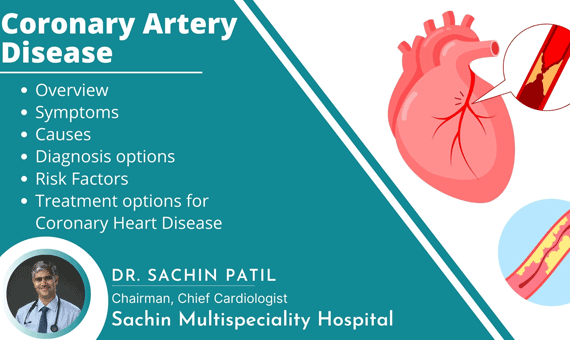
Blog
Coronary Artery Heart Disease
Coronary Artery Disease Dr. Sachin Patil Cover
Overview
Coronary artery disease is a common heart condition. The major blood vessels that supply the heart (coronary arteries) struggle to send enough blood, oxygen and nutrients to the heart muscle. Cholesterol deposits (plaques) in the heart arteries and inflammation are usually the cause of coronary artery disease.
Signs and symptoms of coronary artery disease occur when the heart doesn't get enough oxygen-rich blood. If you have coronary artery disease, reduced blood flow to the heart can cause chest pain (angina) and shortness of breath. A complete blockage of blood flow can cause a heart attack.
Coronary artery disease often develops over decades. Symptoms may go unnoticed until a significant blockage causes problems or a heart attack occurs. Following a heart-healthy lifestyle can help prevent coronary artery disease.Coronary artery disease may also be called coronary heart disease.

Symptoms
Symptoms may go unrecognized at first, or they may only occur when the heart is beating hard like during exercise. As the coronary arteries continue to narrow, less and less blood gets to the heart and symptoms can become more severe or frequent.
Coronary artery disease signs and symptoms can include:
Chest pain (angina): Symptoms may go unrecognized at first, or they may only occur when the heart is beating hard like during exercise. As the coronary arteries continue to narrow, less and less blood gets to the heart and symptoms can become more severe or frequent.
Shortness of breath: You may feel like you can't catch your breath.
Fatigue: If the heart can't pump enough blood to meet your body's needs, you may feel unusually tired.
Heart attack: A completely blocked coronary artery will cause a heart attack. The classic signs and symptoms of a heart attack include crushing chest pain or pressure, shoulder or arm pain, shortness of breath, and sweating. Women may have less typical symptoms, such as neck or jaw pain, nausea and fatigue. Some heart attacks don't cause any noticeable signs or symptoms.
Causes
Development of atherosclerosis
Coronary artery disease starts when fats, cholesterols and other substances collect on the inner walls of the heart arteries. This condition is called atherosclerosis. The build-up is called plaque. Plaque can cause the arteries to narrow, blocking blood flow. The plaque can also burst, leading to a blood clot.
Besides high cholesterol, damage to the coronary arteries may be caused by:
- Diabetes or insulin resistance
- High blood pressure
- Not getting enough exercise (sedentary lifestyle)
- Smoking or tobacco use





